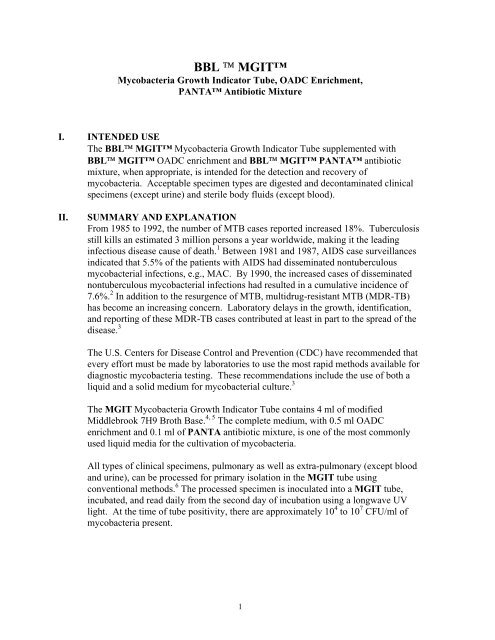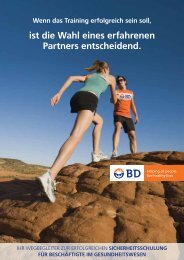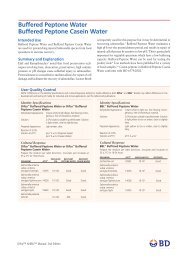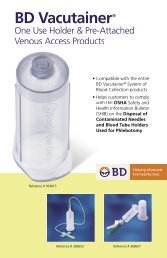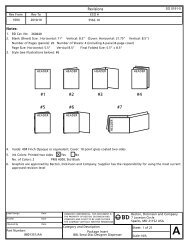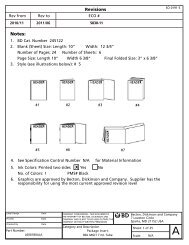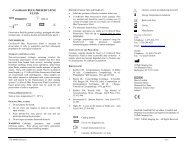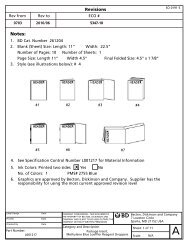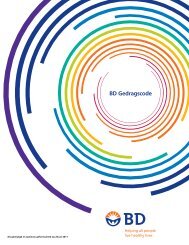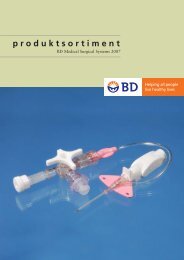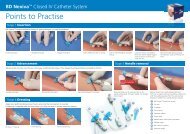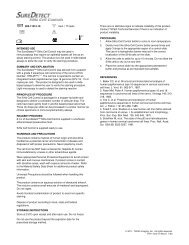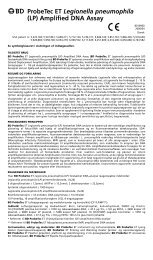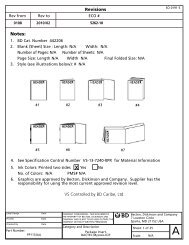BBL ™ MGIT™ - BD
BBL ™ MGIT™ - BD
BBL ™ MGIT™ - BD
Create successful ePaper yourself
Turn your PDF publications into a flip-book with our unique Google optimized e-Paper software.
<strong>BBL</strong> MGIT<br />
Mycobacteria Growth Indicator Tube, OADC Enrichment,<br />
PANTA Antibiotic Mixture<br />
I. INTENDED USE<br />
The <strong>BBL</strong> MGIT Mycobacteria Growth Indicator Tube supplemented with<br />
<strong>BBL</strong> MGIT OADC enrichment and <strong>BBL</strong> MGIT PANTA antibiotic<br />
mixture, when appropriate, is intended for the detection and recovery of<br />
mycobacteria. Acceptable specimen types are digested and decontaminated clinical<br />
specimens (except urine) and sterile body fluids (except blood).<br />
II. SUMMARY AND EXPLANATION<br />
From 1985 to 1992, the number of MTB cases reported increased 18%. Tuberculosis<br />
still kills an estimated 3 million persons a year worldwide, making it the leading<br />
infectious disease cause of death. 1 Between 1981 and 1987, AIDS case surveillances<br />
indicated that 5.5% of the patients with AIDS had disseminated nontuberculous<br />
mycobacterial infections, e.g., MAC. By 1990, the increased cases of disseminated<br />
nontuberculous mycobacterial infections had resulted in a cumulative incidence of<br />
7.6%. 2 In addition to the resurgence of MTB, multidrug-resistant MTB (MDR-TB)<br />
has become an increasing concern. Laboratory delays in the growth, identification,<br />
and reporting of these MDR-TB cases contributed at least in part to the spread of the<br />
disease. 3<br />
The U.S. Centers for Disease Control and Prevention (CDC) have recommended that<br />
every effort must be made by laboratories to use the most rapid methods available for<br />
diagnostic mycobacteria testing. These recommendations include the use of both a<br />
liquid and a solid medium for mycobacterial culture. 3<br />
The MGIT Mycobacteria Growth Indicator Tube contains 4 ml of modified<br />
Middlebrook 7H9 Broth Base. 4, 5 The complete medium, with 0.5 ml OADC<br />
enrichment and 0.1 ml of PANTA antibiotic mixture, is one of the most commonly<br />
used liquid media for the cultivation of mycobacteria.<br />
All types of clinical specimens, pulmonary as well as extra-pulmonary (except blood<br />
and urine), can be processed for primary isolation in the MGIT tube using<br />
conventional methods. 6 The processed specimen is inoculated into a MGIT tube,<br />
incubated, and read daily from the second day of incubation using a longwave UV<br />
light. At the time of tube positivity, there are approximately 10 4 to 10 7 CFU/ml of<br />
mycobacteria present.<br />
1
III. PRINCIPLES OF THE PROCEDURE<br />
A fluorescent compound is embedded in silicone on the bottom of 16 x 100 mm<br />
round-bottom tubes. The fluorescent compound is sensitive to the presence of<br />
oxygen dissolved in the broth. Initially, the large amount of dissolved oxygen<br />
quenches emissions from the compound and little fluorescence can be detected.<br />
Later, actively respiring microorganisms consume the oxygen and allow the<br />
fluorescence to be observed using a 365 nm UV transilluminator or longwave UV<br />
light (Wood’s lamp). Growth can also be detected by the presence of a nonhomogeneous<br />
turbidity or small grains or flakes in the culture medium.<br />
The medium components are substances essential for the rapid growth of<br />
mycobacteria. Oleic acid is utilized by tubercle bacilli and plays an important role in<br />
the metabolism of mycobacteria. Albumin acts as a protective agent by binding free<br />
fatty acids, which may be toxic to Mycobacterium species, thereby enhancing their<br />
recovery. Dextrose is an energy source. Catalase destroys toxic peroxides that may<br />
be present in the medium.<br />
Contamination may be reduced by supplementing the combined <strong>BBL</strong> MGIT base<br />
and <strong>BBL</strong> MGIT OADC enrichment with the <strong>BBL</strong> MGIT PANTA antibiotic mixture<br />
prior to inoculation with a clinical specimen.<br />
IV. REAGENTS<br />
The <strong>BBL</strong> MGIT Mycobacteria Growth Indicator Tube contains: 110 µl of<br />
fluorescent indicator and 4 ml of broth. The indicator contains Tris 4, 7 - diphenyl-1,<br />
10-phenanthroline ruthenium chloride pentahydrate in a silicone rubber base. The<br />
tubes are flushed with 10% CO2 and capped with polypropylene caps.<br />
Approximate Formula � Per L Purified Water<br />
Modified Middlebrook 7H9 Broth base .......... 5.9 g<br />
Casein peptone ................................................ 1.25 g<br />
<strong>BBL</strong> MGIT OADC contains 15 ml Middlebrook OADC enrichment.<br />
Approximate Formula � Per L Purified Water<br />
Bovine albumin ..................................... 50.0 g Catalase ........... 0.03 g<br />
Dextrose ................................................ 20.0 g Oleic acid ........ 0.6 g<br />
The <strong>BBL</strong> MGIT PANTA vial contains a lyophilized mixture of antimicrobial agents.<br />
Approximate Formula � Per Vial Lyophilized PANTA<br />
Polymyxin B ................................... 6,000 units Trimethoprim ... 600 µg<br />
Amphotericin B ..................................... 600 µg Azlocillin ......... 600 µg<br />
Nalidixic acid ......................................... 2,400 µg<br />
� Adjusted and/or supplemented as required to meet performance criteria.<br />
Directions for Use: Reconstitute a lyophilized vial of <strong>BBL</strong> MGIT PANTA<br />
antibiotic mixture with 3 ml of sterile distilled or deionized water.<br />
2
Pathogenic microorganisms including Hepatitis B Virus and Human<br />
Immunodeficiency Virus may be present in specimens. “Universal<br />
Precautions” 6,7 should be followed in handling all items contaminated with blood<br />
or other body fluids.<br />
Precautions: For in vitro Diagnostic Use.<br />
Working with Mycobacterium tuberculosis grown in culture requires Biosafety Level<br />
3 practices, containment equipment and facilities. 6<br />
Prior to use, each MGIT tube should be examined for evidence of contamination or<br />
damage. Discard any tubes if they appear unsuitable or exhibit fluorescence prior to<br />
use.<br />
Dropped tubes should be examined carefully. If damage is seen, the tube should be<br />
discarded.<br />
Wear UV protective glasses when observing fluorescence and use only longwave<br />
illumination (365 nm). DO NOT USE SHORTWAVE UV LIGHT FOR READING<br />
TUBES.<br />
Autoclave all inoculated MGIT tubes prior to disposal.<br />
Storage of Reagents: <strong>BBL</strong> MGIT Mycobacteria Growth Indicator Tubes - On<br />
receipt, store at 2 to 25°C (35 to 77°F). DO NOT FREEZE. Minimize exposure to<br />
light. Broth should appear clear and colorless. Do not use if turbid. MGIT tubes<br />
stored as labeled prior to use may be inoculated up to the expiration date and<br />
incubated for up to eight weeks.<br />
<strong>BBL</strong> MGIT OADC - On receipt, store in the dark at 2 to 8°C. Avoid freezing or<br />
overheating. Do not open until ready to use. Minimize exposure to light.<br />
<strong>BBL</strong> MGIT PANTA Antibiotic Mixture - On receipt, store lyophilized vials at 2 to<br />
8°C. Once reconstituted, the PANTA mixture may be used within 72 h, provided it is<br />
stored at 2 to 8°C, or up to 6 months if stored at -20°C or colder. Once thawed, the<br />
PANTA mixture must be used immediately. Discard unused portion.<br />
3
V. SPECIMEN COLLECTION AND HANDLING<br />
All specimens should be collected and transported as recommended by the CDC, the<br />
6, 8<br />
Clinical Microbiology Procedures Handbook or your laboratory procedure manual.<br />
VI. DIGESTION, DECONTAMINATION AND CONCENTRATION<br />
Specimens from different body sites should be processed for inoculation of MGIT<br />
tubes as follows:<br />
SPUTUM: Specimens should be processed using the NALC-NaOH method as<br />
recommended by the CDC’s Public Health Mycobacteriology: A Guide for the Level<br />
III Laboratory. 6 Alternatively, use the <strong>BBL</strong> MycoPrep kit for processing<br />
mycobacterial specimens (see “Availability”).<br />
GASTRIC ASPIRATES: Specimens should be decontaminated as for sputum. If the<br />
volume of the specimen is more than 10 ml, concentrate by centrifugation.<br />
Resuspend the sediment in about 5 ml of sterile water and then decontaminate. Add a<br />
small amount of NALC powder (50 to 100 mg) if the specimen is thick or mucoid.<br />
After decontamination, concentrate again prior to inoculation into MGIT tube.<br />
BODY FLUIDS (CSF, synovial fluid, pleural fluid, etc.): Specimens which are<br />
collected aseptically and are expected to have no other bacteria can be inoculated<br />
without decontamination. If the specimen volume is more than 10 ml, concentrate by<br />
centrifugation at 3,000 x g for 15 min. Pour off supernatant fluid. Inoculate MGIT<br />
tube with sediment. Specimens that are expected to contain other bacteria must be<br />
decontaminated.<br />
TISSUE: Tissue specimens should be processed as recommended by the CDC’s<br />
Public Health Mycobacteriology: A Guide for the Level III Laboratory. 6<br />
STOOL: Suspend 1 g of feces in 5 ml of Middlebrook Broth. Agitate the suspension<br />
on a vortex mixer for 5 sec. Proceed to the NALC-NaOH procedure as recommended<br />
by the CDC’s Public Health Mycobacteriology: A Guide for the Level III<br />
Laboratory. 6<br />
VII. PROCEDURE<br />
Materials Provided: <strong>BBL</strong> MGIT Mycobacteria Growth Indicator Tubes, 4 ml,<br />
package of 25 and 100 Tubes, or <strong>BBL</strong> MGIT OADC, 6 vials, 15 ml, or <strong>BBL</strong><br />
MGIT PANTA antibiotic mixture, 6 lyophilized vials (see “Availability”).<br />
4
Materials Not Provided: Falcon brand 50 ml centrifuge tubes, 4% sodium<br />
hydroxide, 2.9% sodium citrate solution, N-acetyl-L-cysteine powder, phosphate<br />
buffer pH 6.8, vortex mixer, 37°C incubator, 1 ml sterile pipettes, sterile transfer<br />
pipettes, UV transilluminator (365 nm) or Wood’s lamp with longwave bulb or<br />
blacklight, 0.4% sodium sulfite solution (procedure below), <strong>BBL</strong> Middlebrook and<br />
Cohn 7H10 Agar, <strong>BBL</strong> MycoPrep, <strong>BBL</strong> Middlebrook 7H9 Broth (see<br />
“Availability”) or other mycobacterial agar or egg-based medium, tissue homogenizer<br />
or sterile swab, <strong>BBL</strong> Normal Saline (see “Availability”), ATCC® strains #27294,<br />
12478, 6841, microscope and materials for staining slides, pipettes 100 µl and 500 µl,<br />
corresponding pipette tips, 5% sheep blood agar plate, Eye Guard Spectacles (UVP<br />
#UVC-303, San Gabriel, CA) and tuberculocidal disinfectant.<br />
Inoculation of MGIT Tubes:<br />
1. Label the MGIT tube with specimen number.<br />
2. Unscrew the cap and aseptically add 0.5 ml of MGIT OADC.<br />
3. Aseptically add 0.1 ml of reconstituted MGIT PANTA antibiotic mixture. For<br />
best results, the addition of OADC enrichment and PANTA antibiotic mixture<br />
should be made just prior to specimen inoculation.<br />
4. Add 0.5 ml of the concentrated specimen suspension prepared above. Also add a<br />
drop (0.1ml) of specimen to a 7H10 agar plate or other mycobacterial solid agar<br />
or egg-based medium. NOTE: Specimen volumes greater than 0.5 ml can<br />
increase contamination or otherwise adversely affect the performance of the<br />
tubes.<br />
5. Tightly recap the tube and mix well.<br />
6. Tubes should be incubated at 37°C.<br />
• For specimens in which mycobacteria with different incubation requirements<br />
are suspected, a duplicate MGIT tube can be set up and incubated at the<br />
appropriate temperature; e.g. 30°C or 42°C. Inoculate and incubate at the<br />
required temperature.<br />
• For specimens suspected of containing Mycobacterium haemophilum, a<br />
source of hemin must be introduced into the tube at the time of inoculation<br />
and the tube incubated at 30°C. Aseptically place one strip of <strong>BBL</strong> Taxo<br />
X Factor Strip into each MGIT tube requiring the addition of hemin prior to<br />
inoculation of specimen (see “Availability”).<br />
7. Read tubes daily starting on the second day of incubation following the procedure<br />
“Reading the Tubes” below.<br />
Preparation of Interpretive Negative and Positive Control Tubes: Use of the<br />
Positive and Negative Control tubes is only for the interpretation of fluorescence and<br />
is not intended as a control for the performance of the media.<br />
5
Positive Control Tube:<br />
1. Empty broth from an uninoculated MGIT tube.<br />
2. Label tube as a Positive Control and record the date.<br />
3. Prepare 0.4% sodium sulfite solution (0.4 g in 100 ml sterile distilled or deionized<br />
water). Discard unused portion.<br />
4. Add 5 ml of sodium sulfite solution to the tube, replace the cap, tighten and allow<br />
the tube to stand for a minimum of 1 h at room temperature before use.<br />
5. Positive Control tubes can be used many times. Each Positive Control tube can<br />
be used for up to four weeks when stored at room temperature.<br />
Negative Control Tube: An unopened, uninoculated MGIT tube is used as a<br />
control.<br />
Reading the Tubes:<br />
1. A Positive Control and a Negative Control are important for correctly interpreting<br />
results.<br />
2. Remove tubes from the incubator. Place tubes on the UV light next to a Positive<br />
Control tube and an uninoculated tube (Negative Control). It is recommended<br />
that one rack at a time of tubes (4 by 10 tubes) be placed on the UV light. NOTE:<br />
Wear UV protective glasses when observing fluorescence. Normal room light is<br />
preferred. Avoid reading tubes in a sunlit room or in a darkened room.<br />
3. Visually locate MGIT tubes that show bright fluorescence. Fluorescence is<br />
detected as a bright orange color in the bottom of the tube and also an orange<br />
reflection on the meniscus. The MGIT tube should then be taken out of the rack<br />
and compared to Positive Control and Negative Control tubes. The Positive<br />
Control should show a high amount of fluorescence (very bright orange color).<br />
The Negative Control should have very little or no fluorescence. If fluorescence<br />
in the MGIT tube looks more like the Positive Control, it is a positive tube.<br />
If it looks more like the Negative Control, it is a negative tube. Growth can also<br />
be detected by the presence of a non-homogeneous turbidity, small grains or<br />
flakes in the culture medium.<br />
4. Positive tubes should be stained for acid-fast bacilli. Smear-negative tubes should<br />
be checked for bacterial contamination. Subcultures for identification and drug<br />
susceptibility testing may be performed using fluid from the <strong>BBL</strong> MGIT tube.<br />
5. Negative tubes should continue to be read daily for eight weeks or longer<br />
depending on the type of specimen and the past experience of the laboratory.<br />
Alternative reading schedules may be established. Failure to read the tubes for<br />
several days, such as during weekends or holidays, may delay the detection of<br />
positive tubes, but will not otherwise adversely affect the performance of the<br />
media. Tubes should be visually checked for the presence of turbidity and small<br />
grains or granules before discarding. Negative MGIT tubes cannot be reused. If<br />
mycobacterial growth is suspected, follow the “Processing a Positive MGIT<br />
Tube” procedure as stated below.<br />
6
Reprocessing Contaminated MGIT Tubes: Contaminated MGIT tubes may be redecontaminated<br />
and re-concentrated using the same procedure used to process the<br />
specimen initially.<br />
1. Add the contents of the contaminated MGIT tube to a 50 ml plastic centrifuge<br />
tube.<br />
2. Add 5 ml NALC-NaOH solution to the centrifuge tube. With the cap tightened,<br />
vortex the tube for 5 to 20 sec.<br />
3. Allow the tube to stand for 15 to 20 min. Do not treat for more than 20 min.<br />
4. Add 35 ml sterile phosphate buffer pH 6.8. Replace the cap and mix the contents.<br />
5. Concentrate the specimen in a centrifuge at a speed of 3,000 x g for 15 min.<br />
6. Carefully decant the supernatant fluid from the pellet. Resuspend the pellet using<br />
a sterile Pasteur pipette with phosphate buffer pH 6.8.<br />
7. Inoculate 0.5 ml of the suspension to a new MGIT tube.<br />
User Quality Control: Upon receipt of a new shipment or lot number of MGIT<br />
tubes, it is suggested that suspensions of the ATCC control organisms be prepared in<br />
Middlebrook 7H9 Broth.<br />
1. From solid media cultures less than 15 days old, prepare a suspension in<br />
Middlebrook 7H9 Broth.<br />
2. Allow the suspension to sit for 20 min.<br />
3. Transfer the supernatant to an empty, sterile tube and allow to sit for an additional<br />
15 min.<br />
4. Transfer the supernatant to another empty, sterile tube.<br />
5. Adjust the suspension to a turbidity comparable to a 0.5 McFarland standard.<br />
6. Dilute the control organism suspensions following the dilution scheme outlined in<br />
Table 1.<br />
7. Inoculate the MGIT tubes following the “Inoculation of MGIT Tubes”<br />
procedure.<br />
The MGIT tubes should show fluorescence within the time frame shown in Table 1.<br />
Table 1<br />
Species ATCC® Numbers Dilution of 0.5<br />
McFarland in<br />
7<br />
Saline<br />
Days to Positive<br />
M. tuberculosis 27294 1:50 6 - 10<br />
M. kansasii 12478 1:5000 7 - 11<br />
M. fortuitum 6841 1:5000 2 - 3<br />
At the time of tube positivity, there are approximately 10 4 to 10 7 CFU/ml of<br />
mycobacteria present. If the QC MGIT tubes do not give the expected results, do not<br />
use the remaining tubes until you have contacted Technical Services at<br />
(800) 638-8663 (United States only).<br />
VIII. RESULTS
A culture-positive sample is identified by the observation of fluorescence or nonhomogenous<br />
turbidity, small grains or flakes in an inoculated MGIT tube. Positive<br />
tubes should be subcultured and an acid-fast smear prepared. A positive acid-fast<br />
smear result indicates the presumptive presence of viable microorganisms in the tube.<br />
Processing a Positive MGIT Tube:<br />
NOTE: All steps should be performed in a biological safety cabinet.<br />
1. Remove MGIT tube from test rack.<br />
2. Using a sterile transfer pipet, remove an aliquot from the bottom of the tube<br />
(approx. 0.1 ml) for stain preparations (AFB and Gram stains).<br />
3. Inspect smear and preparations. Report preliminary results only after acid-fast<br />
stain evaluation.<br />
If AFB positive, subculture to solid media and report as: Growth positive, AFB<br />
smear positive, ID pending.<br />
If microorganisms other than AFB are present, report as: Growth positive, AFB<br />
smear negative, Contaminated.<br />
If no microorganisms are present, no reportable result. Subculture broth to blood<br />
agar plate and mycobacterial culture medium; repeat smear using the addition of<br />
protein to ensure the inoculum has been adequately fixed to the slide.<br />
IX. LIMITATIONS OF THE PROCEDURE<br />
Recovery of mycobacteria in the MGIT tube is dependent on the number of<br />
organisms present in the specimen, specimen collection methods, patient factors such<br />
as presence of symptoms, prior treatment and the method of processing.<br />
Decontamination with the N-acetyl-L-cysteine Sodium hydroxide (NALC-NaOH) or<br />
Oxalic acid methods is recommended. Other decontamination methods have not been<br />
tested in conjunction with the <strong>BBL</strong> MGIT medium. Digestant-decontaminant<br />
solutions may have harmful effects on mycobacteria.<br />
Colony morphology and pigmentation can only be determined on solid media.<br />
Mycobacteria may vary in acid-fastness depending on strain, age of culture and other<br />
variables. The consistency of microscopic morphology in <strong>BBL</strong> MGIT medium<br />
has not been established.<br />
An AFB smear-positive MGIT tube can be subcultured, to both selective and<br />
nonselective mycobacterial media, for isolation to perform identification and<br />
susceptibility testing.<br />
MGIT tubes which appear positive may contain other non-mycobacterial species.<br />
Non-mycobacterial species may overgrow mycobacteria present. Such MGIT tubes<br />
should be re-decontaminated and re-cultured.<br />
8
MGIT tubes which appear positive may contain one or more species of<br />
mycobacteria. Faster growing mycobacteria may develop positive fluorescence prior<br />
to slower growing mycobacteria; therefore, it is important to subculture positive<br />
MGIT tubes to ensure proper identification of all mycobacteria present in the sample.<br />
Specimen volumes greater than 0.5 ml can increase contamination or otherwise<br />
adversely affect the performance of the MGIT tubes.<br />
Due to the richness of the MGIT broth and to the non-selective nature of the MGIT<br />
indicator, it is important to follow the stated digestion/decontamination procedure to<br />
reduce the possibility of contamination. Adherence to procedural instructions is<br />
critical for optimum recovery of mycobacteria.<br />
The use of PANTA antibiotic mixture, although necessary for all non-sterile<br />
specimens, may have inhibitory effects on some mycobacteria.<br />
Terminal subcultures were not routinely performed during clinical studies.<br />
Therefore, an actual false negative rate (defined as a MGIT tube that remained<br />
negative throughout the eight-week incubation period, was subcultured and grew a<br />
mycobacterial organism) cannot be determined at this time.<br />
Seeded culture studies were performed with twenty-three species (ATCC and wild<br />
strains) of mycobacteria using inoculum levels ranging from 10 3 and 10 5 CFU/ml.<br />
The following species were detected as positive in the MGIT tube:<br />
M. africanum M. intracellulare M. smegmatis<br />
M. avium Complex� M. kansasii ∗ M. szulgai<br />
M. chelonae � M. malmoense M. terrae<br />
M. flavescens � M. marinum M. triviale<br />
M. fortuitum � M. nonchromogenicum M. tuberculosis �<br />
M. gastri M. phlei M. vaccae<br />
M. gordonae� M. scrofulaceum M. xenopi� M. haemophilum M. simiae� � Species recovered during clinical evaluation of the MGIT tube.<br />
Clinical studies have demonstrated recovery of mycobacteria from respiratory<br />
specimens, gastric aspirates, tissue, stool and sterile body fluids except blood;<br />
recovery of mycobacteria from other body fluids has not been established for this<br />
product.<br />
X. PERFORMANCE CHARACTERISTICS<br />
The <strong>BBL</strong> MGIT Mycobacteria Growth Indicator Tube was evaluated at six clinical<br />
sites, which included public health laboratories as well as large acute care hospitals in<br />
geographically diverse areas. The site population included patients infected with<br />
HIV, immunocompromised patients and transplant patients. The <strong>BBL</strong> MGIT tubes<br />
were compared to the BACTEC 460TB radiometric system, the <strong>BBL</strong> SEPTI-<br />
9
CHEK AFB Mycobacteria Culture System and conventional solid growth media<br />
for the detection and recovery of mycobacteria from clinical specimens (except blood<br />
and urine). A total of 2801 specimens were tested during the study. The distribution<br />
of specimens tested by source was: respiratory (78%), gastric (0.4%), body fluid<br />
(9.8%), tissue (7.0%), stool (2.5%) and other (2.4%). A total of 318 specimens were<br />
positive which represented 330 isolates recovered during the study. Of these 330<br />
isolates, 253 (77%) were recovered by the <strong>BBL</strong> MGIT tubes, 260 (79%) were<br />
recovered by the BACTEC 460TB and the <strong>BBL</strong> SEPTI-CHEK AFB and 219 (66%)<br />
were recovered by conventional solid media. The <strong>BBL</strong> MGIT tubes demonstrated a<br />
0.5% false positive rate (MGIT fluorescent, no AFB present). The <strong>BBL</strong> MGIT tubes<br />
failed to recover 3.7% of the isolates which were recovered in one or more of the<br />
reference systems (BACTEC 460TB, <strong>BBL</strong> SEPTI-CHEK AFB or conventional<br />
solid media). While this percentage represents a potential loss of recovery, it is not<br />
indicative of an actual false negative determination (refer to “Limitations of the<br />
Procedure” section). Use of a second medium, as recommended, will increase the<br />
probability of recovery of mycobacterial organisms. The average breakthrough<br />
contamination rate for the <strong>BBL</strong> MGIT tubes was 9.7%.<br />
BACTEC SITES<br />
Table 2-Detection of Mycobacteria Positive Isolates in Clinical Evaluations<br />
Isolate Total Total MGIT Total BACTEC Total CONV<br />
Isolates MGIT Only BACTEC Only CONV Only<br />
MTB 113 91 2 98 7 92 6<br />
MAC 99 76 9 86 13 57 3<br />
M. kansasii 5 2 0 5 1 4 0<br />
M. fortuitum 9 5 3 3 1 5 3<br />
M. chelonae 2 0 0 2 1 1 0<br />
M. xenopi 2 0 0 2 2 0 0<br />
M. simiae 1 1 0 1 0 0 0<br />
M. gordonae 11 4 1 4 1 9 5<br />
M. flavescens 2 1 0 2 1 0 0<br />
All MYCO 244� 180� 15� 203 27 168 17<br />
�NOTE: Fourteen MGIT ONLY isolates are not included in these data. Presumptive<br />
identification was performed with no final confirmation of ID.<br />
10
SEPTI-CHEK SITES<br />
Table 3-Detection of Mycobacteria Positive Isolates in Clinical Evaluations<br />
Isolate<br />
Total<br />
Isolates<br />
Total MGIT<br />
MGIT Only<br />
11<br />
Total SEPTI-<br />
SEPTI – CHEK<br />
CHEK Only<br />
Total CONV<br />
CONV Only<br />
MTB 30 25 1 29 2 26 0<br />
MAC 34 26 5 28 2 25 0<br />
M. kansasii 1 1 1 0 0 0 0<br />
M. gordonae 2 2 2 0 0 0 0<br />
All MYCO 67 � 54 � 9 � 57 4 51 0<br />
� NOTE: Five MGIT ONLY isolates are not included in these data. Presumptive<br />
identification was performed with no final confirmation of ID.<br />
XI. AVAILABILITY<br />
Cat. No. Description<br />
245111 <strong>BBL</strong> MGIT Mycobacteria Growth Indicator Tubes, 4 ml, carton of 25<br />
tubes.<br />
245113 <strong>BBL</strong> MGIT Mycobacteria Growth Indicator Tubes, 4 ml, carton of 100<br />
tubes.<br />
245116 <strong>BBL</strong> MGIT OADC, 15 ml, carton of 6 vials. Each vial sufficient for 25<br />
MGIT tubes.<br />
245114 <strong>BBL</strong> MGIT PANTA Antibiotic Mixture, lyophilized, carton of 6 vials.<br />
Each vial sufficient for 25 MGIT tubes.<br />
<strong>BBL</strong> Lowenstein-Jensen Medium Slants, package of 10 (20 x 148 mm tubes<br />
with cap).<br />
<strong>BBL</strong> Lowenstein-Jensen Medium Slants, carton of 100 (20 x 148 mm tubes<br />
with cap).<br />
<strong>BBL</strong> MycoPrep Specimen Digestion/Decontamination Kit, ten 75 ml bottles<br />
of NALC-NaOH solution and 5 packages of phosphate buffer.<br />
<strong>BBL</strong> MycoPrep Specimen Digestion/Decontamination Kit, ten 150 ml<br />
bottles of NALC-NaOH solution and 10 packages of phosphate buffer.<br />
<strong>BBL</strong> Middlebrook and Cohn 7H10 Agar, carton of 100.<br />
<strong>BBL</strong> Middlebrook 7H9 Broth, 8mL, package of 10 tubes.<br />
<strong>BBL</strong> Normal Saline, 5 mL, package of 10.<br />
<strong>BBL</strong> Normal Saline, 5mL carton of 100.<br />
<strong>BBL</strong> Taxo X Factor Strips, 1 vial, 30 discs.
XII. REFERENCES<br />
1. Bloom, B.R., and C.J.L. Murray. 1992. Tuberculosis: commentary on a<br />
reemergent killer. Science 257:1055-1064.<br />
2. Horsburg Jr., C.R. 1991. Mycobacterium avium complex infection in the acquired<br />
immunodeficiency syndrome. N. Engl. J. Med. 324:1332-1338.<br />
3. Tenover, F.C., et al. 1993. The resurgence of tuberculosis: Is your laboratory<br />
ready? J. Clin. Microbiol. 31:767-770.<br />
4. Cohn, M.L., R.F. Waggoner, and J.K. McClatchy. 1968. The 7H11 medium for<br />
the cultivation of mycobacteria. Am. Rev. Resp. Dis. 98:295-296.<br />
5. Youmans, G.P. 1979. Cultivation of mycobacteria, the morphology and<br />
metabolism of mycobacteria, p. 25-35. Tuberculosis. W.B. Saunders Company,<br />
Philadelphia.<br />
6. Kent, P.T., and G.P. Kubica. 1985. Public health mycobacteriology: a guide for<br />
the level III laboratory. USDHHS, Centers for Disease Control, Atlanta.<br />
7. Bloodborne pathogens. Code of Federal Regulations, Title 29, Part 1910.1030,<br />
Federal Register 1991, 56:64175-64182.<br />
8. Isenberg, Henry D. (ed.). 1992. Clinical microbiology procedures handbook,<br />
vol. 1. American Society for Microbiology, Washington, D.C.<br />
TECHNICAL INFORMATION: In the United States, telephone Technical Services, toll<br />
free, (800) 638-8663.<br />
Approved By:_________________________<br />
Date Effective:________________________<br />
Supervisor____________________________ Date_______________<br />
Director ____________________________ Date_______________<br />
Reviewed:<br />
12<br />
PI Rev. 12/01<br />
Rev. 1/02


